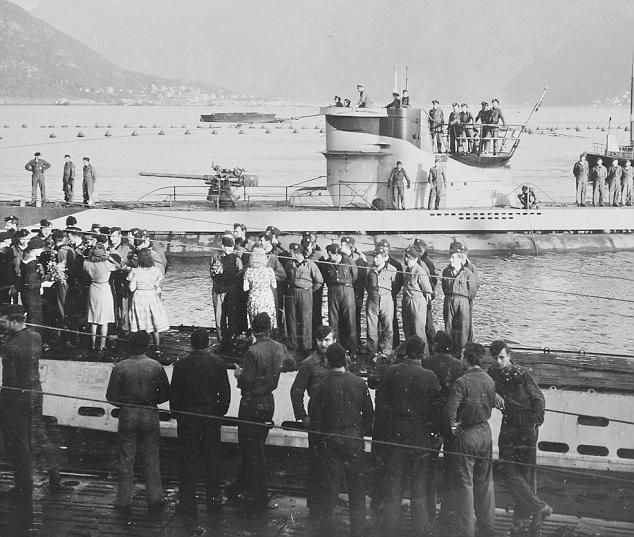
World War II Norway: Naval Operations (1940-45)

Figure 1.--The successful German seizure of Norway had serious repercussions in the crucial Battle of the Atlantic. The Royal Navy in World War II managed to bittle of the German Navy by massive mine fields in the North Sea. U-boats managed to get through, but it significantly restricted their operations. Possession of Norway and Luftwaffe operationd from Norway, made this impossible in World War II. In addition U-boats were able to operate from Norwegiam ports, extending the range of U-boat opertions. These advatages were, however, to the opportunities provuded by the fall of France 2 months later. Here a U-boat enters a Norwegian port (July 1942) to a low-key welcoming party. We are not sure who the women are.
|
|
Control of Norway at first was useful to the NAZIs for both naval and air bases. The air bases proved of little use in the Battle of Britain because of the limted range of German fighters. They could not escort the bombers on raids. And the bombers sent on unescorted raids were savaged buy the RAF fighters alerted by the Chain Home Radio network. These bases did make it impossible for the Royal Navy to bottle up the U-boats and other commerce raiders in the North Sea as they had to an extent done in World War I. Norway provide the Germans vital naval bases. U-boats operated from Norway for 5 years (1940-45). U-boats began using Norwegian ports soon after the invasion (April 1940). U-boats operated from Bergen, Narvik, Trondheim, Hammerfest and Kirkenes. Initial planning for U-boat bunkers began (late-1940). The Todt Organisation began building bunkers in Bergen and Trondheim which were completed between 1942 and 1943.
The Luftwaffe provided air cover to coastal shipping and mde it difficult fot the Royal Navy to lay the same effective minefields that they laid during World War I. The occupation of France, however, made this advantage less important that it seemed as the U-boats began operating from French Atlantic ports. Many units, however, also operated from Norwegian bases. The French and Norwegian bases were a huge advantage that the U-boats did not have in World War I. U-boats leaving from Kiel and other ports would usually call in at Norwegian based before venturing out into the Atlantic. The Norwegian bases were used to both extend the range of operations out into the Atlantic and to intercept the Artic convoys to Murmansk and Arlangel. Norway after the invasion of the Soviet Union (June 1941) took on greater importance. The British and than the Americans attempted to ger war material to the Soviet Union. The first convoys were dispatched to the northern ports of Murmansk and Archangel. The Germans were able to launch devestating raids on these convoys from naval and airbases in northern Norway. The fall of France meant that the U-bots primarily used the French Atlantic ports for the crucial period of Battle of the Atlantic (1940-43). The liberation of France mean that the Norwegian bases took on more importance, but by this time the Allied anti-submarine operations had defeated the U-bot threat ad it was increasingly dangerous for U-boats to venture into the Atlantic. More than 240 U-boats eventully operated from Norwegian bases for at least part of the War. They were primarily part of the 11th U-boat Flotilla. Norway was still in German hab\nds when the NAZIs surrendered (May 1945). While the U-boat bases were the most important German naval operations in Norway, some of the Kreigsmarine surface units were also based in Norway. While the Kreigsmarine destroyer force was largely destroyed in the invasion of Norway, several of its its major fleet elements were deployed to Norway.
CIH -- WW II

Navigate the CIH World War II Section:
[Return to Main World War II Norwegian page ]
[Return to Main World War II German Invasion page ]
[Return to Main World War II country page ]
[Return to Main World War II displaced children page]
[Return to the Main World War II page]
[About Us]
[Aftermath]
[Biographies]
[Campaigns]
[Children]
[Countries]
[Deciding factors]
[Diplomacy]
[Geo-political crisis]
[Economics]
[Home front]
[Intelligence]
[POWs]
[Resistance]
[Race]
[Refugees]
[Technology]
[Totalitarian powers]
[Bibliographies]
[Contributions]
[FAQs]
[Images]
[Links]
[Registration]
[Tools]
[Return to Main World War II page]
[Return to Main war essay page]
[Return to CIH Home page]
Created: 9:46 AM 1/6/2013
Last updated: 11:59 PM 5/6/2016



